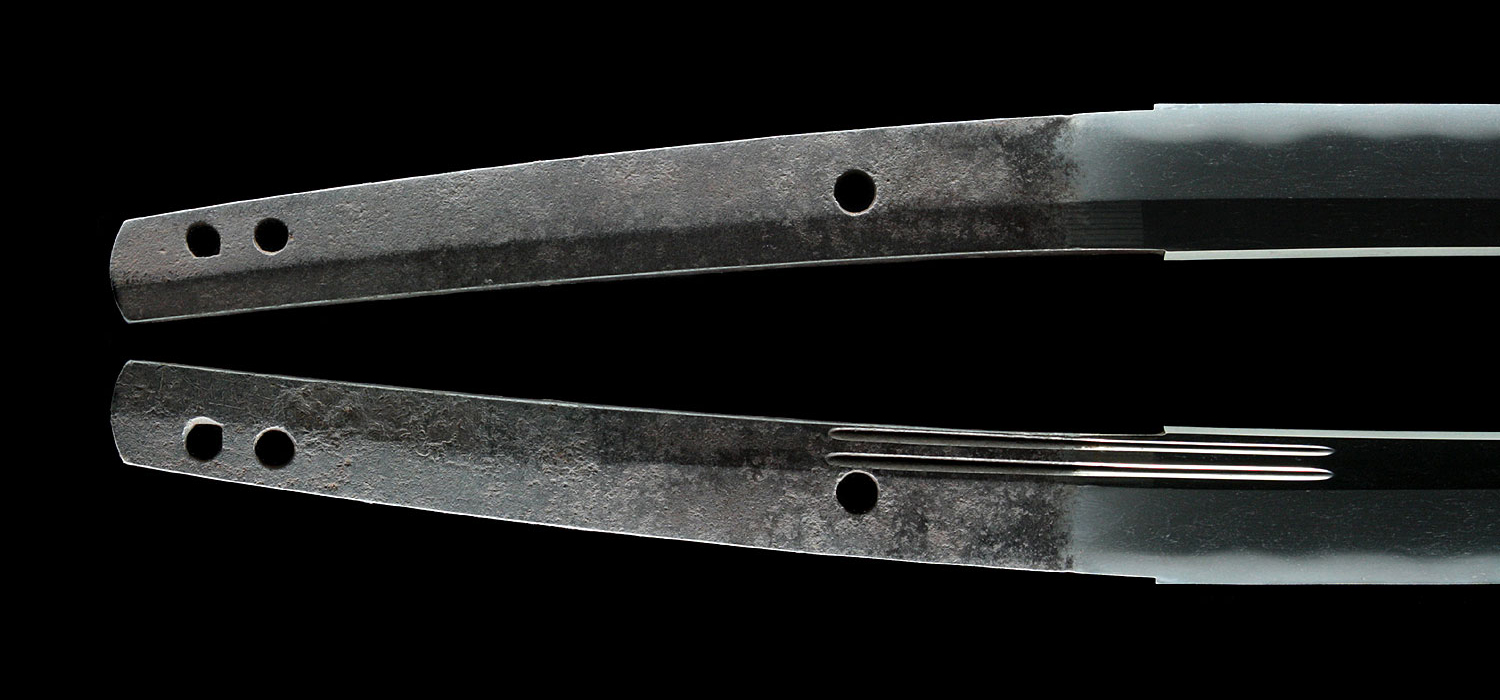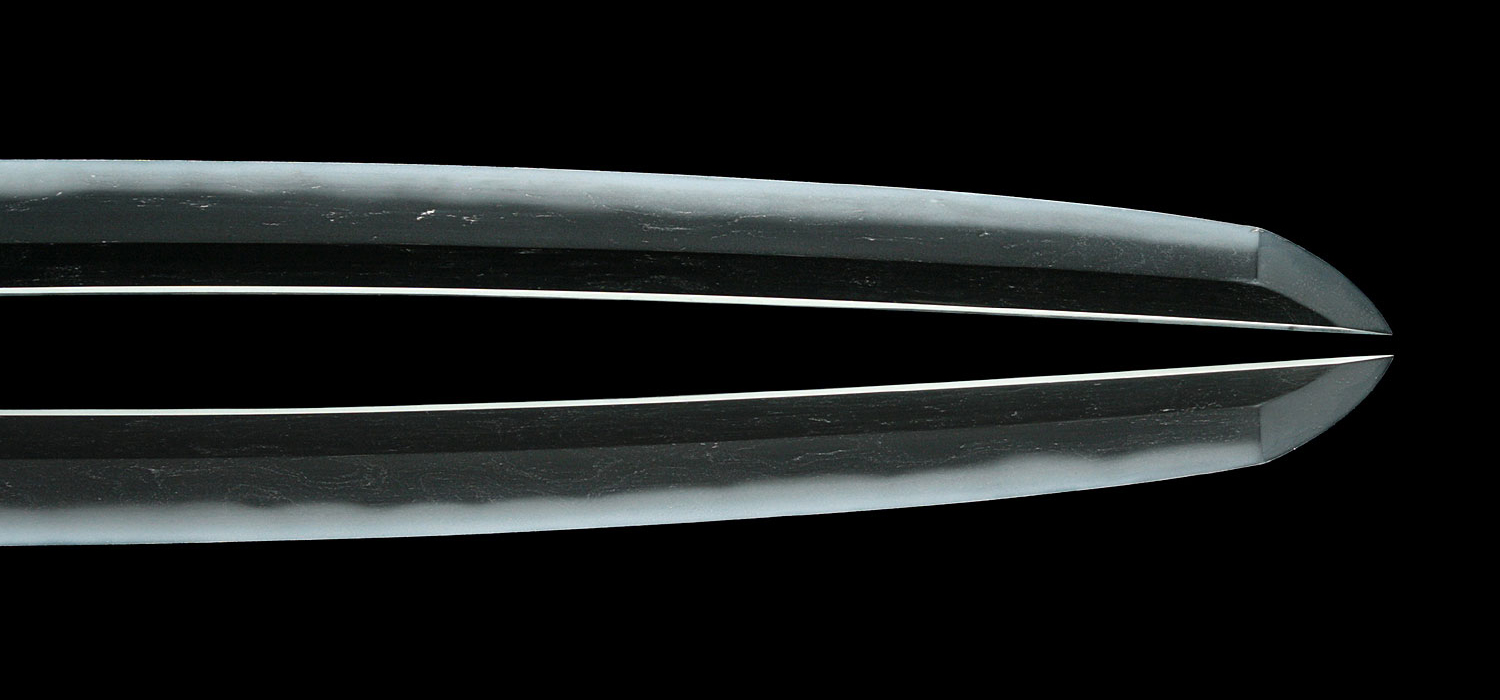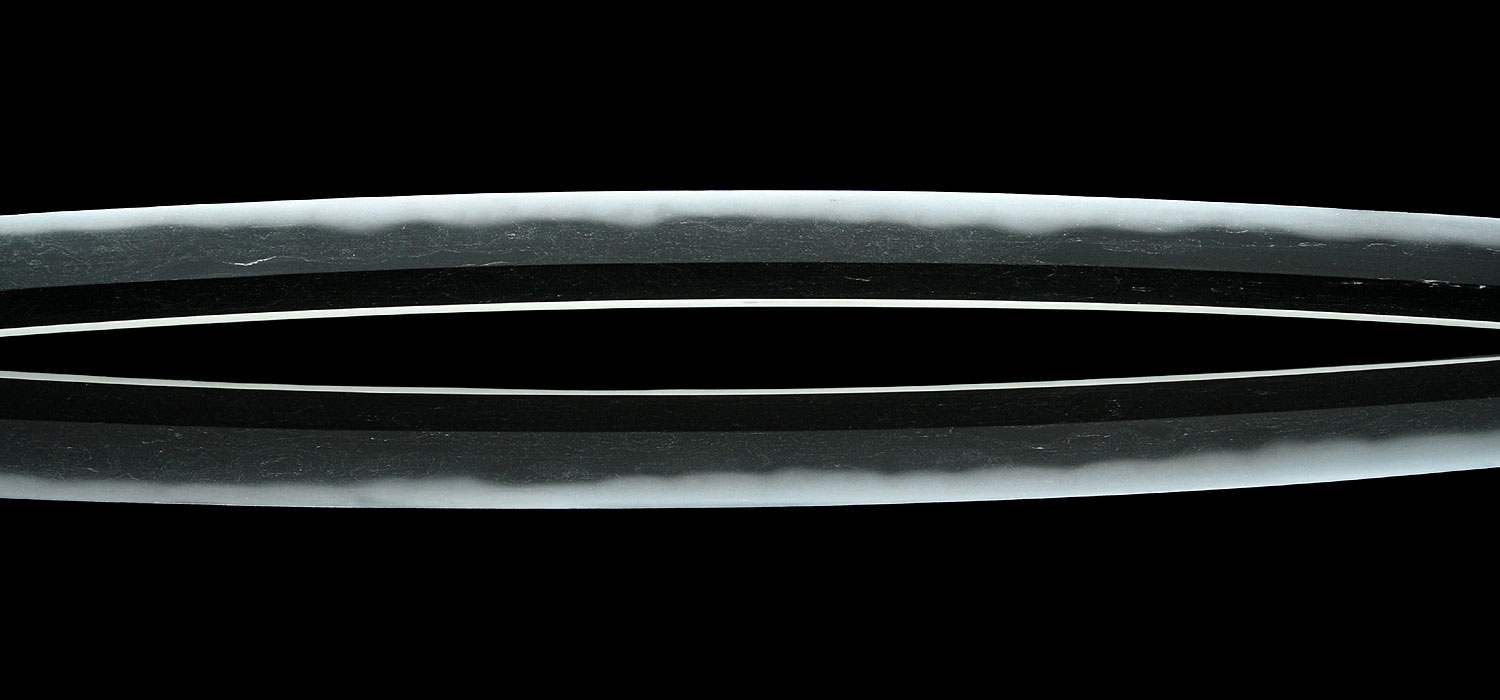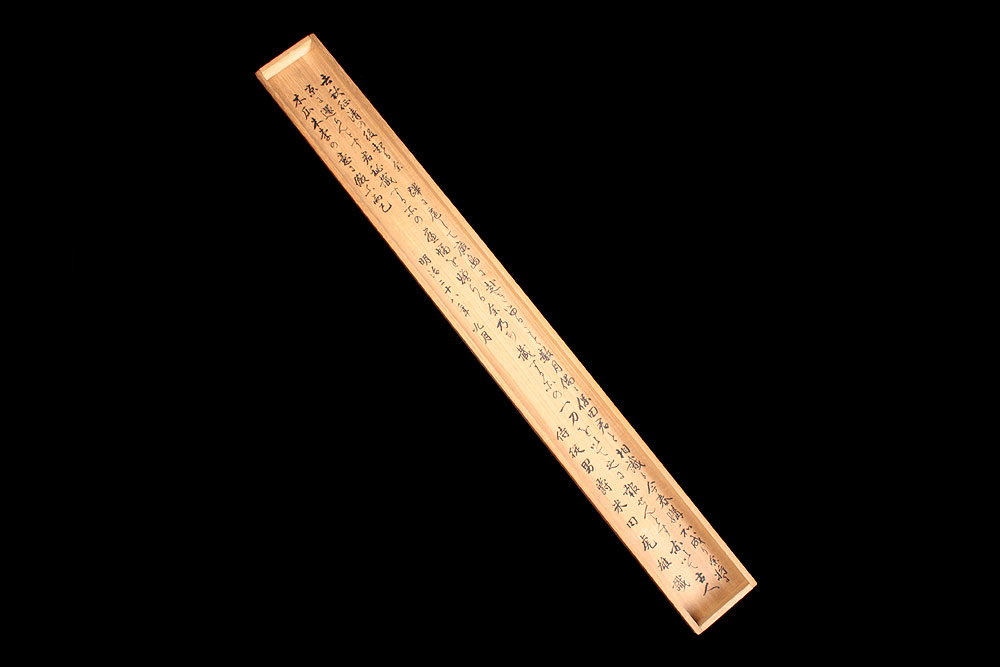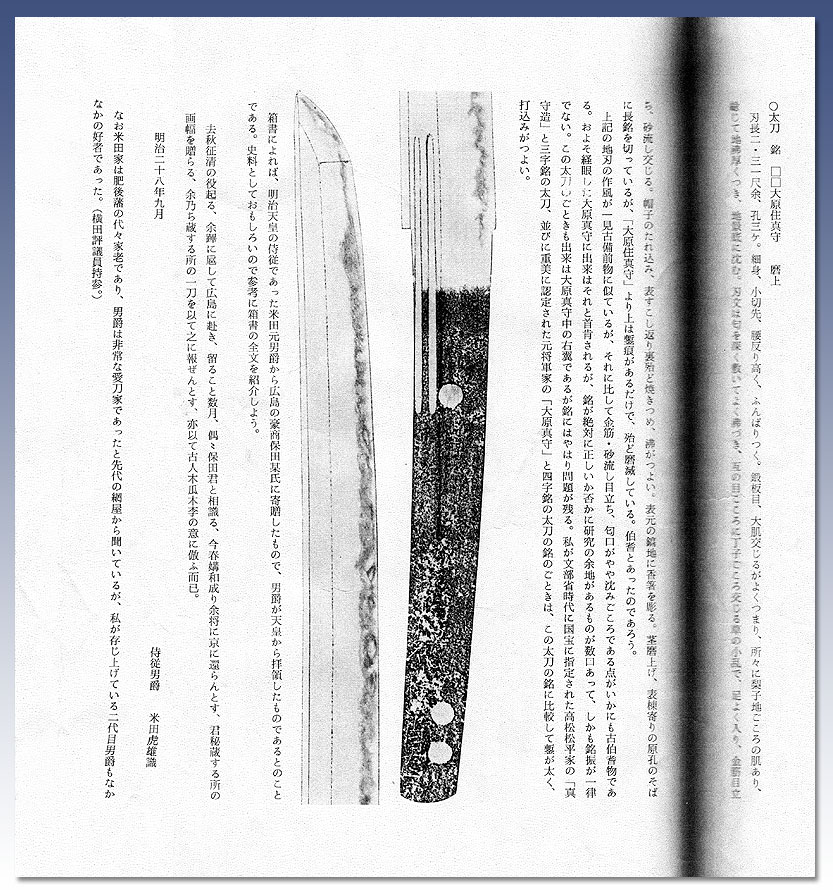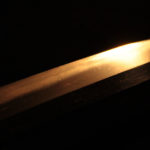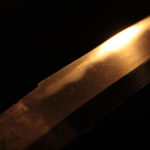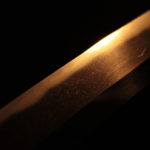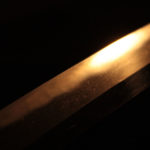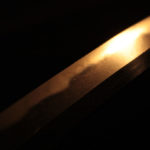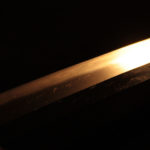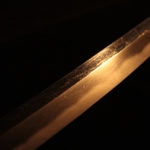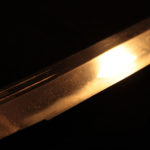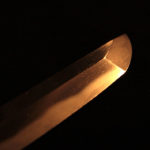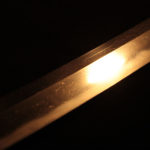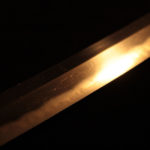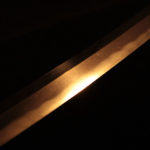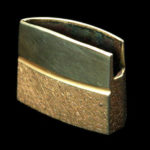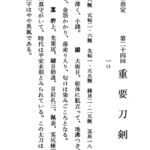Gallery Page (Display Only)
Made during the Heian period (794-1185 AD)
Sayagaki by Hon’ami Nisshu (Ningen Kokuho – National Treasure)
Listed in Dr Honma’s book “Kanto-Hibi-shou“
With wooden storage container
Notes Gifted by Grand Chamberlain of Japan
Certification Rating: Juyo Token by N.B.T.H.K.
Description
This is an impressive Juyo blade by Ōhara Sanemori (真守). Depending on what reference you read, there are four different times when the Ōhara Sanemori smiths worked. Hō´en (保延, 1135-1141), Hōki – „Sanemori tsukuru“ (真守造), „Sanemori“ (真守), „Ōhara Sanemori“ (大原真守), Hōki Ōhara Sanemori“ (伯耆大原真守), according to transmission the son of Yasutsuna (安綱) in Hoki-no-kuni (Tottori prefecture). Old sword publications date him also to the eras Kōnin (弘仁, 810-824), Jōwa (承和, 834-848) or Kashō (嘉祥, 848-851), his blades have a small kissaki, a pronounced funbari, and a deep koshizori which starts right at the habaki area, that means they show the typical tachi-sugata of the Heian period, the jigane is a standing-out ō-itame mixed with areas of inhomogeneous steel and chikei, the hamon is a rather subdued and hazy nie-loaden ko-midare with sunagashi, the signatures on extant works suggest that there were several generations active with that name, it is said that he signed with the pseudonym “Gatsu´yō Unkaku“ (月卿雲客) after retiring, another theory says that he was the same smith as “Gyōnin” (行忍), saijō-saku.

The sayagaki was written by Hon’ami Nisshu in 1974 with his kaō (signature), a Ningen Kokuho (Living National Treasure), his given name was Takeo and he died in July, 1995. He was the eldest son of Hirai Chiba and was adopted by Hon’ami Ringa in 1924. He was designated as Ningen Kokuho in 1975 along with a fellow polisher Ono Kokei. It was the first designation from the field of sword polishing. Master Hon’ami Nisshu was the 17th master of a long family tradition of sword polishers and connoisseurs who had served the Imperial court as well as the clans of Tokugawa and Nobunaga, major warlords of Japan warrior period. Also they served for Shogun Ashikaga and Maeda family having a deep artistic talents also for poetry, lacquering, painting, pottery.
We believe this was made in the latter half of the Heian era, the sayagaki by Hon’ami Nisshu however narrows down the time frame and states his opinion as being made around 841-851 AD during the Japanese era Kashō (aka Kajō). This sword shows Hoki-no-kuni characteristics of same period well. Unfortunately the original Juyo paper was lost, this sword now has a replacement Juyo paper, called a Shomeisho (pictured below). This sword is listed in the book “Kanto-hibi-shou” by Dr. Junji Honma (Kunzan), see picture of page inserted below.
The pictured storage container (inside lid) has writings by that of Torao Yoneda, A Grand Chamberlain of Japan from 1878–84. He wrote about and during the time of Nisshin Senso (First Sino-Japanese War in 1894) and how an exchange of gifting took place with this sword and a Mr. Yasuda while Emperor Meiji visited Hiroshima city. At this time, Hiroshima Prefecture and the Imperial headquarters were also transferred there. It is thought that Emperor Meiji gave Mr. Yoneda this sword in order to re-gift to Mr. Yasuda as if it was a sword of his own. It is thought that the gifting occurred as an appreciation by the Emperor to show his appreciation to Mr. Yasuda. Mr. Yasuda was a businessman of Hiroshima. The board of Chamberlains at that time was the division of the Imperial Household Agency responsible for organizing the daily life and schedule of the Emperor. In old Japanese, the Chamberlain was also known as Maetsukimi.
Hawley rates the Sanemori working 848-854 at 250 points, and Toko taikan rates him at 15,000,000 ¥. There exists blades that are Tokubetsu Juyo & Juyo Bunkazai by Ōhara Sanemori. The Ōhara school was one of the earliest schools dating back to the 9th century.
Sagayaki
The sayagaki by Hon’ami Nisshu is translated as: Hoki-no-kuni Ōhara Sanemori; the Board of Chamberlains [this was the occupation of Tsuda], Tsuda legacies goods [The treasure which came to the Tsudas family from generation to generation]; slightly suriage mei; time: around [Japanese era Kashō (aka Kajō)] 841-851), fine sword; length 2 shaku, 3 sun, 1 bu and half. In Showa 49 (1974) authenticated and written by Hon’ami Nisshu (Kaō).
Wooden Box Cover
The outer lid of box is translated as: Tachi made by Ōhara Sanemori, Living in Hoki. Hoki-no-kuni Ohara Sanemori Tachi, one item (hito furi)
Wooden Inner Box Lid
I came to know Mr. Yasuda while I was in Hiroshima for several months during the Japanese-Sino War before the Emperor Meiji. A pair of hanging rolls was presented to the Emperor Meiji (by Mr. Yasuda) upon return to Kyoto after reconciliation of the War. In appreciation, I presented Mr. Yasuda the treasured sword.
September 1895, Confirmed and recorded by Torao YONEDA, Chamberlain [1878–84] and Baron
Kanto Hibi shou by Dr. Honma Junji (Kunzan)
Translation – page above from Dr Honma’s book
About 2.31-shaku blade length, three holes, slender body, small point, big koshizori, and taper (funbari). Kitae itame. Some mixture of a large grain pattern (o-hada) yet packed well, with some surface grain pattern resembling the flesh of a sliced pear (nashiji). Ji-nie is thick in general, and chikei sinks on the bottom.
The hamon pattern filled with nioi has many nie, with komidare mixed with gunome (zig zag pattern) and choji, entering with a sufficient leg. The kinsuji is outstanding, along with sunagashi. The boshi (tempered point) has the notarekomi style with slightly curving surface, and the back is mostly yakitsume with strong nie. Incense chopsticks are inscribed on the shinogiji on the surface. The tang (nakago) is cut short (suriage) and a long name (mei) is inscribed on the side of the original hole near the front ridge (mune); however only punch marks (tagane ato) remain above Ōhara ju SANEMORI, and are mostly worn out. It was probably read as Houki.
The style of blade in the above appears to resemble Ko-Bizen mono, while it is really like Ko-Hoki mono in the sense that kinsuji and sunagashi is outstanding with a feeling of faint nioikuchi. It is the very workmanship of Ōhara SANEMORI when examined with experienced eyes. In comparison with the inscription of this tachi, the chisel is wide for strong inscription in the case of the tachi with 3-letter inscription of “SANEMORI tsukuru” in the Takamatsu-Matsudaira family designated as a national treasure as well as the tachi with 4-letter inscription of “Ōhara SANEMORI” in the former shogun family designated as an art treasure.
According to the note of authentication on the box containing the tachi, the former Baron YONEDA who was a chamberlain for the Meiji Emperor presented it to Mr. Yasokichi YASUDA, a wealthy merchant in Hiroshima, after the Emperor presented it to the Baron. The full text of the note of authentication is introduced in the following, as it is also of interest as a historical material.
I came to know Mr. Yasuda while I was in Hiroshima for several months during the Japanese-Sino War before the Emperor Meiji. A pair of hanging rolls was presented to the Emperor Meiji (by Mr. Yasuda) upon return to Kyoto after reconciliation of the War. In appreciation, I presented Mr. Yasuda the treasured sword.
September 1895, Confirmed and recorded by Torao YONEDA, Chamberlain and Baron
The YONEDA family served as a chief retainer for the Higo Clan for generations, and barons also loved swords very much according to the late Amiya. The second-generation baron that I know of was also a passionate lover.
Juyo "Shomeisho certificate
Juyo Shomeisho are replacement papers for lost original Juyo papers.
Juyo Zufu paper & translation
24th Juyo – July 10th, 1977
length : 70.1cm ~ 27.6″
curvature : 2.6cm
basis width : 2.6cm
top width : 1.55cm
kissaki length : 2.25cm
nakago length : 18.1cm
nakago curvature : 0.2cm
shape : Shinogi-zukuri, Ihorimune, Tight, Ubu-nakago, deeply a curve, Ko-kissaki
ji : O-itame closely, Jinie, Jifu
ha : Ko-midare, Ko-nie, Sunagashi, Kinsuji, Yubashiri
boshi : Yakitsume
curving : front / Gomabashi [grooves]
nakago : Suriage, Kuri-jiri, 3 mekugi ana
The Blade
This Sword is not available for purchase.
If you wish to purchase a Japanese Sword, please view our Nihonto for sale page or contact us directly via email or by telephone at 1(608) 315-0083 any time. Please include specifics of what you seek, i.e.: Katana, maker, era, price range, etc.
Pictures and content may not be copied without the express permission of samuraisword.com ©


